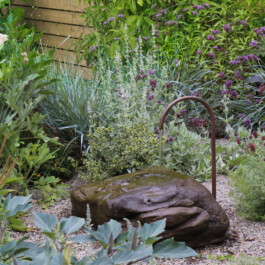bird bath


Walking around Oakland's neighborhoods, we are endlessly entertained by how different each garden is from the next. Just within the block you can run into a yard full of chickens, giant fox tail agaves, a massive banana plant, or a fragrant jasmine vine that overflows onto the sidewalk. These little moments and joyful memories inspired this experimental edible garden.
The owners are passionate about growing their own vegetables and South Asian herbs in the garden. One also loves the vibrant colors of his childhood in Singapore, and the other has an interest in native plants and birds. If there's any climate that can support this mix, it's Oakland's, so we decided to embrace the botanical melting pot approach and mix tropical, edible, native, and habitat supporting species all together.



We used Riverwash boulders as stepstones and to create a hand-carved, recirculating fountain. It has been the local birds' favorite bathing spot since the installation.

We calibrated the irrigation zones to accommodate the mix of South Asian herbs and native Californian plants. We micro-graded areas so certain plants would stay in or out of moist soil longer and set different irrigation zones: summer dry, moderate, and grey water irrigation for the trees.
And Voilà! Within a few months, this gravel garden exploded with lushness.

Clinopodium douglasii, Yerba Buena, hugging the boulder in the foreground. Persicaria odorata is in the background. Common names include laksa leaf, Vietnamese cilantro, hot mint and Cambodian mint. It is an herb whose leaves are used in Southeast Asian and Northeast Indian cuisines. Symphytum officinale, Common Comfrey, is also in the background. Although mildly toxic, comfrey has a long history as a medicinal herb that has been used for thousands of years around the world. Comfrey has been a major hit amongst humming birds, bees and butterflies!


Below, Datura wrightii is slowly peeling to reveal its spiky seed balls. It's a vigorous native perennial that can be spotted growing wild in the deserts of Southern California and New Mexico. People may know of this species for its toxicity or from Georgia O'keeffe's famous painting, 'Jimson Weed'. Like many other nightshade species we love, it's a nocturnal queen that opens up at night and withers after sunrise the following morning when the fog burns off.










Globe Artichoke & Hollyhock "Black Knight" for drama



Landscape Construction by Sendan Construction. The water fountain was carved by talented artist and stonemason, Jee-Shaun Wang. Photography by Lucky Banks-Kenny and SOFT STUDIO.